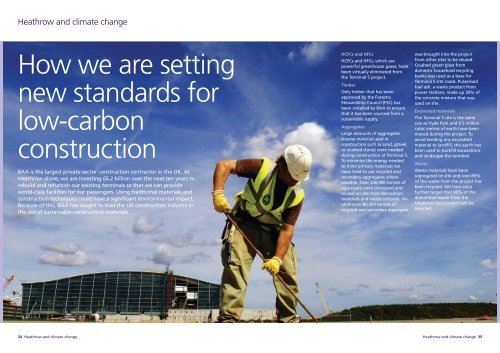Heathrow Airport's emissions reductions efforts - Airports Council ...
Heathrow Airport's emissions reductions efforts - Airports Council ...
Heathrow Airport's emissions reductions efforts - Airports Council ...
Create successful ePaper yourself
Turn your PDF publications into a flip-book with our unique Google optimized e-Paper software.
Addressing <strong>emissions</strong> from flightsAirspace managementInfrastructure constraintsAir traffic control is still largelyorganised on nationalboundaries. This means thataircraft frequently fly a ‘dog-leg’route rather than flying in astraight line. The additional fuelused to fly these circuitous routesprovides no benefit to anyone –increasing journey times forpassengers and the amount ofcarbon dioxide produced duringa flight. Around six milliontonnes of CO2 have already beensaved by shortening existingroutes and BAA is pushing for aunified system of air trafficmanagement within the EU tosignificantly reduce <strong>emissions</strong>within Europe. IATA estimatesthat a single air trafficmanagement system for the EUcould cut aviation CO2 <strong>emissions</strong>by 12%. 45One way of reducing the demandfor air travel is to prevent anymore airport infrastructure frombeing built. If there are no morerunways then there is a limit tohow many more flights arepossible.In fact, airport infrastructureconstraints already form part ofUK aviation policy. In its 2003 AirTransport White Paper theGovernment allowed for someadditional airport capacity, butdid not allow for all of theunconstrained capacity that wasforecast. For example, even witha third runway, <strong>Heathrow</strong> wouldonly be meeting some 70% of itsunconstrained growth forecast in2030. 46However, other countries are notadopting the same policy. Overthe next five years China plans toinvest in 71 airport expansionprojects, including building 49new airports. 47Today, <strong>Heathrow</strong> is full, operatingat 99% of its permitted runwaycapacity, and a failure to allowfor any new capacity at all couldhave serious economicconsequences, both at a regionaland national level. Theinternational connectivityprovided by <strong>Heathrow</strong> supportsbillions of pounds of Britishexports, thousands of UK jobs,and means that hundreds ofbusinesses choose to locate in theUK, who would otherwise locateoverseas. (For a detailedexamination of <strong>Heathrow</strong>’seconomic importance see ourpublication Economic Benefits of<strong>Heathrow</strong> available atwww.baa.com/publications)Worse still, future growth in airtravel – along with the businessesthat are based in West Londonand the Thames Valley – couldmigrate elsewhere. If there areno available landing slots at<strong>Heathrow</strong> then airlines willsimply fly from other Europeanhubs instead. That does nothingto combat climate change butdamages the UK economy andLondon’s status as Europe’spremier financial and commercialcentre.The Stern Review on theEconomics of Climate Changestated that capacity limits atairports are a poor way of dealingwith the challenge of climatechange, noting that they are “aform of rationing which is aninefficient way of regulatingdemand”. Capacity constraints leadto more congestion and delays,causing aircraft to be held forlonger in stacks. This needlesslypollutes the atmosphere whileaircraft wait for a landing slot.The Stern Reviewstated thatcapacity limits atairports is aninefficient wayof regulatingdemandTaxes and chargesThe main tax on flying at presentis Air Passenger Duty. This iscurrently levied at £10 for shorthaul flights and £40 for long-haulflights and raises almost £2 billionfor the Treasury each year.There are two main problemswith Air Passenger Duty as a wayof tackling climate change:• it is a tax on passengers not<strong>emissions</strong>. Airlines are notincentivised to directly reduce<strong>emissions</strong>.• the money that is raiseddoesn’t go towardsaddressing environmentalimpacts or incentivising cleantechnology.Putting tax on fuel is frequentlysuggested as a way of combatingcarbon dioxide <strong>emissions</strong> fromaviation. The main problem withthis idea is that it only applies tofuel purchased in the UK. Onmany short-haul flights theairline could simply choose to fillup their fuel tanks abroad –avoiding the tax and actuallyincreasing their CO2 <strong>emissions</strong> byflying heavier fully-fuelledaircraft. There are alsointernational agreements thatprevent states from levying taxon international aviation fuelmeaning that in practice thiscould only be applied to domesticflights. Like Air Passenger Dutythe money raised would not gotowards addressingenvironmental impacts.18 <strong>Heathrow</strong> and climate change<strong>Heathrow</strong> and climate change 19

















